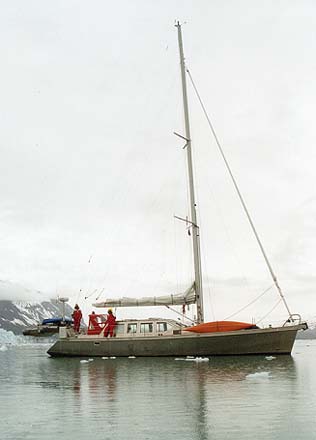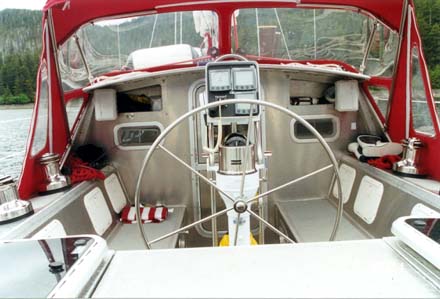


| L.O.A. | 14.00m | 45'11" |
| D.W.L. | 13.24m | 43'5" |
| BEAM | 3.85m | 12'8" |
| DRAFT | 1.80m | 6'3" |
| DSPL | ||
| lightship | 10,720kg | 23,600lb |
| fully loaded | 13,600kg | 30,000lb |
| SAIL AREA | ||
| Main | 56.91sqm | 612sqft |
| Jib | 40.43sqm | 435sqft |
| Staysail | 12.74sqm | 137sqft |
The R14m is designed for long distance cruising with an easily driven hull of moderate beam and displacement,long waterline and veed sections which ensures very good sailing performance and directional stablility.
Check out the adventures of SV Falcon GT, built in Toronto Canada. On completion, Falcon GT sailed from New York to Australia via South Africa and is now located in New Zealand.
The R14m was the first of the full aluminium kit yachts which followed on from the R1000 Series steel cruising yachts and a number of custom aluminium and steel yachts which were built using the same design and construction techniques. The Aluminium Kit Construction section describes the characteristics of the R14m hull, general design considerations, plus assembly, typical plates and components and materials list.
The first 14m kit was cut by Northwest Plasma Cutting in Seattle, WA, USA. Northwind Marine in Seattle, WA, USA built the hull and deck to lockup stage before shipping to Canada for the interior fitout. On completion, the yacht was delivered to the owner in Juneau, Alaska. Northwest has also cut 2 14m kits for Canadian clients.
On the R14m, complete aluminium structure of the hull and deck was 3D computer modelled, then broken down into individual components and nested onto standard size plates ready for plasma cutting using NC files. The components cut includes all the frames, floors, keel floors, watertight bulkheads, keel plating, rudder and skeg, transom, deck, house and cockpit plating, hatch coamings, internal window frames, bow fitting, backbone and stem, keel base, bulwark - everything except the hull plating. All the notches for hull stringers and longitudinals were cut into the frames and floors for easy assembly.
Use the navigation aids at the top of the page to view photos of the R14m.
The aim of this design was to produce a capable cruising yacht with twin cabins, large galley and a saloon where you can sit down and still see out the windows. An inside steering position is located at the forward end of the starboard saloon settee. Considerable stowage space is available outboard of the settees under the side decks. The chart table is located at the aft end of the pilot house just inside the companionway. Aft of the chart table is a quarter berth - or more stowage lockers if required. The window option shows deck hatches in either side of the pilot house for extra ventilation. There are opening ports in the forward house plus an array of hatches in the house tops. Use the navigation aids at the top of the page to view the accommodation layout of the R14m.

The pilot house extends over the forward end ofthe 2m long cockpit to give excellent weather protection for the companionway and cockpit seats. It is possible to see over the pilot house when standing at the wheel or seated on the aft coaming -which incorporates a liferaft locker.
For those seeking greater sun protection, it is possible to have a part or fully covered cockpit and still sail. There is plenty of stowage space with coaming and cockpit lockers, gas bottle locker in the side deck and a large lazarette. The lazarette is accessed by two deck hatches and is divided from the accommodation by a watertight bulkhead. Transom step leads to the boarding platform. The deck edge has a bulwark - 100 to 200mm high - instead of an aluminium toerail. Forward, a collision bulkhead separates the anchor locker and self-draining chain locker from the forward cabin. The anchor winch is aft of the collision bulkheads to protect the electrics. The anchor can be left stowed on the bow rollers during shorter trips, or in the anchor locker.
The keel stepped fractional rig has double swept back spreaders, chainplates at the deck edge for extra support, a furling jib and in-boom furling main. There are no overlapping working sails and optional runners for easy handling. Use the navigation aids at the top of the page to view the sail plan of the R14m.
| Waterline | Displacement | Loading | ||
|---|---|---|---|---|
| 25mm (1") Up | 10,720kg | 23,633lb | 0 | 0 |
| @ D.W.L. | 11,420kg | 25,176lb | 700kg | 1543lb |
| 25mm (1") Down | 12,135kg | 26,750lb | 1,415kg | 3,120lb |
| 50mm (2") Down | 12,872kg | 28,378lb | 12,152kg | 4,744lb |
| Expected Maximum | ||||
| 75mm (3") Down | 13,628kg | 30,045lb | 2,908kg | 6,411lb |
| 100mm (4") Down | 14,401kg | 31,750lb | 3,681kg | 8,115lb |
Based on the loading requirements of liquids, stores and extra equipment for a cruising yacht of 40 - 48ft (which can be from 2,600 to 3,000kg) the following information shows the range of loading and changes in waterlines.
An effort should be made to build and load the yacht within the figures recommended. Overbuilding or adding any unnecessary weight during construction and fitout will detract from optimum loadings.
The hull structure is designed to the A.B.S. Guide for Offshore Racing Yachts which was regularly used for defining structures which have been approved for passenger charter. The hull frame &floor spacings vary depending on local loadings and the accommodation layout. Intermediate floors and longitudinals are installed inway of the keel, engine and mast step. The materials list for the R14m can be found at Aluminium Kit Construction.
| S/L Ratio | Speed - knots | SHP |
|---|---|---|
| 1.00 | 6.59 | 23.40 |
| 1.10 | 7.24 | 31.14 |
| 1.20 | 7.90 | 40.43 |
| 1.3 | 8.56 | 51.40 |
| 1.34 (maximum) | 8.83 | 56.29 |
The maximum hull speed of the R14m, at Speed / Length Ratio (S/L) = 1.34, is 8.83 knots. An efficient cruising speed is at S/L = 1.1, or 7.24 knots. The list shows the required shaft horsepower (SHP) for different speeds at 12,872kg (28,380lb) displacement. Note the rapid increase in required SHP (hence fuel consumption) for small gains in speed.
Based on a speed requirement, select an engine which - running at an optimum RPM - will give the required SHP for that speed.
| Litres l | UK gal | US gal | |
|---|---|---|---|
| Fuel 1 | 160 l | 35 gal | 47 gal |
| Fuel 2 | 220 l | 48 gal | 58 gal |
| Fuel 3 | 210 l | 45 gal | 55 gal |
| Water 1 | 220 l | 48 gal | 58 gal |
| Water 2 | 280 l | 61 gal | 74 gal |
| Sump 1 | 240 l | 52 gal | 63 gal |
| Sump 2 | 125 l | 27 gal | 33 gal |